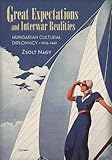Great Expectations and Interwar Realities : Cultural Diplomacy in Horthy's Hungary / Zsolt Nagy.
Material type: TextPublisher: Budapest ; New York : Central European University Press, [2017]Copyright date: 2017Description: 1 online resource (368 p.)Content type:
TextPublisher: Budapest ; New York : Central European University Press, [2017]Copyright date: 2017Description: 1 online resource (368 p.)Content type: - 9789633861950
- 327.439009/042 23
- DB955.4 .N34 2017
- online - DeGruyter
| Item type | Current library | Call number | URL | Status | Notes | Barcode | |
|---|---|---|---|---|---|---|---|
 eBook
eBook
|
Biblioteca "Angelicum" Pont. Univ. S.Tommaso d'Aquino Nuvola online | online - DeGruyter (Browse shelf(Opens below)) | Online access | Not for loan (Accesso limitato) | Accesso per gli utenti autorizzati / Access for authorized users | (dgr)9789633861950 |
Frontmatter -- Table of Contents -- Acronyms and Abbreviations -- Acknowledgements -- Introduction -- Chapter 1. Mobilizing the Nation: From War Propaganda to Peacetime Cultural Diplomacy and Beyond -- Introduction -- From the Emergence of Wartime Propaganda to the Changing Nature of International Relations -- Hungarian Dreamland and Its Destruction, 1918–1920 -- Hungary, 1920–1927: From Turmoil to Consolidation -- 1927: Opening a New Phase -- Stages of Traditional and Cultural Diplomacy, 1927–1941 -- Conclusion -- Chapter 2. Defining the Nation -- Introduction -- National Identity before the Nation-State? -- Post-World War I Crisis of Culture -- Hungarian Nemzetkarakterológia -- Main Themes and Topoi -- Conclusion -- Chapter 3. Educating International Public Opinion: Cultural Institutions and Scholarly Publications -- Introduction -- Institutions -- The Hungarian Reference Library in New York City -- Academic Publishing and Lectures -- Conclusion -- Chapter 4. Showcasing the Nation: The Role of Tourism -- Introduction -- The Hungarian Tourist Industry and the Image of Hungary before Trianon -- “A Country without Mountains or Sea”: The Reorganization of the Hungarian Tourist Industry after World War I -- Tourism Propaganda and the Constant Problem of Image -- Competing Mental and Physical Landscapes of Hungary’s Tourist Image -- 1938: Hopes, Disappointments, and Change -- Conclusion -- Chapter 5. Becoming Audible and Visible: Radio Broadcasting and Cinematic Production in the Service of Cultural Diplomacy -- Introduction -- Radio Broadcasting: Providing Voice for a Nation -- Radio: Cultural Diplomacy’s Sharpest Weapon -- Domestic Challenges: The Hungarianness of Hungarian Radio -- Challenges to the Radio’s Foreign Policy: From “the Battle of Radio Armaments” to War -- The Birth, Destruction, and Rebirth of the Hungarian Movie Industry, 1896–1929 -- Celluloid Résumés: The Role of Kulturfilme and Newsreels -- Conclusion -- Conclusion -- Bibliography -- Index -- Gallery
restricted access online access with authorization star
http://purl.org/coar/access_right/c_16ec
After the shock of the 1920 Treaty of Trianon, which Hungarians perceived as an unfair dictate, the leaders of the country found it imperative to change Hungary’s international image in a way that would help the revision of the post-World War I settlement. The monograph examines the development of interwar Hungarian cultural diplomacy in three areas: universities, the tourist industry, and the media—primarily motion pictures and radio production. It is a story of the Hungarian elites’ high hopes and deep-seated anxieties about the country’s place in a Europe newly reconstructed after World War I, and how these elites perceived and misperceived themselves, their surroundings, and their own ability to affect the country’s fate. The defeat in the Great War was crushing, but it was also stimulating, as Nagy documents in his examination of foreign language journals, tourism, radio, and other tools of cultural diplomacy. The mobilization of diverse cultural and intellectual resources, the author argues, helped establish Hungary’s legitimacy in the international arena, contributed to the modernization of the country, and established a set of enduring national images. Though the study is rooted in Hungary, it explores the dynamic and contingent relationship between identity construction and transnational cultural and political currents in East-Central European nations in the interwar period.
Mode of access: Internet via World Wide Web.
In English.
Description based on online resource; title from PDF title page (publisher's Web site, viewed 20. Nov 2024)


